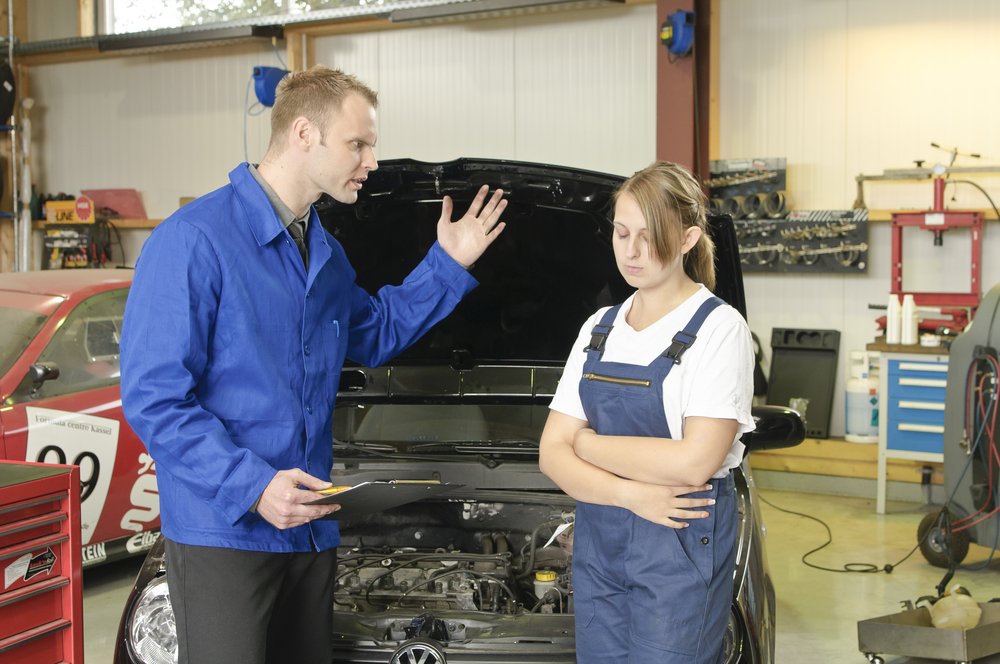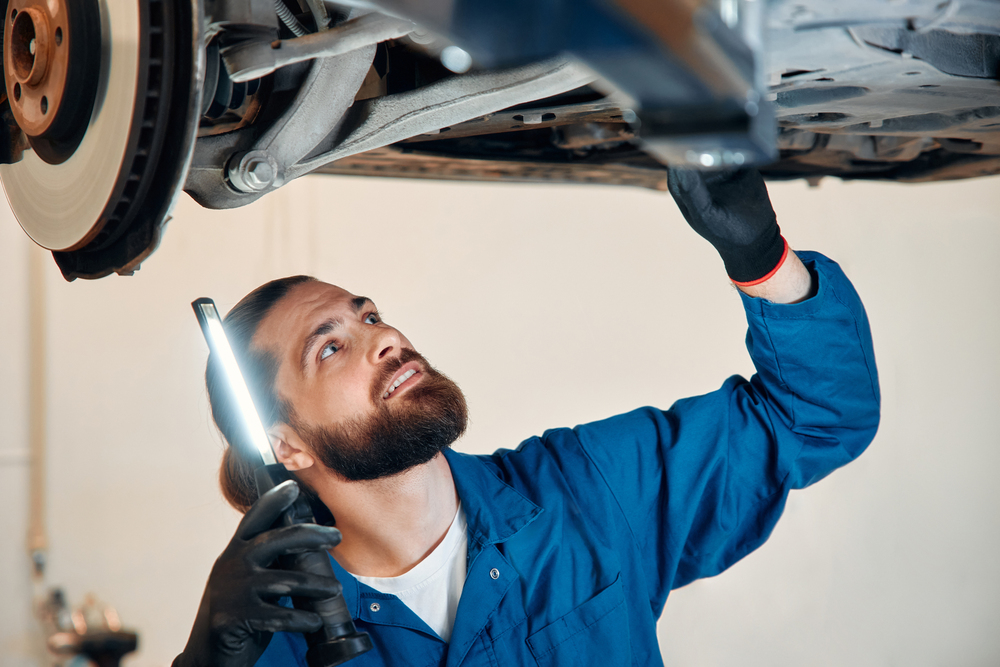By Peter Carter
So your service manager has just taken delivery of an ambulance in need of brakes. It’s a hefty vehicle, tipping the scales at 14,000 lbs. Good thing you have a brand new hoist rated for 15,000 lbs, right?
Wrong, says Steve Perlstein, government sales manager for Mohawk Lifts.
He points out that if the front axle weighs, say, 4,800 lbs and the rear weighs 9,200 lbs, the rear swing arms of the lift are going to be overloaded by about 1,700 lbs.
Perlstein says that ambulance requires a lift with a capacity of at least 18,400 lbs.
The point is, overloading a lift is easy to do. As a matter of fact, it’s really easy to make all kinds of lift mistakes.
We tend to think of lifts as big, dumb machines with a lot of brute strength. But next to your computers, they’re probably the most complicated tools you own. Unfortunately, most technicians are never properly trained on how to use or maintain them.
Hard to say why this should be. Technicians are tinkerers by nature who want to know how everything works. And training is ubiquitous. Lift manufacturers offer education, and many distributors and installers will train operators or offer refresher courses whenever they install new lifts. There’s also a wealth of online training to be found.
But with an influx of less-expensive units from far-afield manufacturers and a general increase in shop liability and work-safety requirements, lift purchasers must step up their training and safety practices. Failing to do so could mean a loss of business or, worse, loss of life.

David Facciol has been making, distributing, fixing, and inspecting lifts since the 1970s. He’s now general manager at Canadian Automotive Service Equipment (CASE), a division of ISN, the largest distributor of Rotary Lifts in the country. He says the problem of lift understanding and familiarity is getting worse rather than better, simply because the market is growing so fast and there’s so much competition from offshore manufacturers.
“You’re not going to believe this,” he tells CARS magazine, “but lifts generally cost less than they did back in the ’80s.”
Facciol says new materials and improved technology have not only broadened garage owners’ choices, but they’ve enabled the “commoditization” of the lift industry.
“People are competing on price,” agrees Kerri Hospes of Calgary-based Atlas Automotive Service Equipment. And in many cases, she says, new lift purchasers forego some of the after-sales service and support offered by the larger, more established manufacturers such as Rotary and Mohawk.
“A new shop owner should be able to start without breaking the bank,” she says. (In fact, she can outfit a first-time garage owner with a two-post lift, a tire changer, and a balancer for about $8,000!) But bargain-basement prices often mean that the essential training and maintenance duties end up being outsourced – and sometimes forgotten.

Flavio Cella, who works in the eight-bay family-owned shop in Bolton, Ont. that his father Bruno started in 1980, says nickel-and-diming lift purchases is a bad idea.
“They’re one tool you have to have ready when you want it,” Cella says in an interview.
An engineer by training, he’s an evangelist for daily lift upkeep.
“Dad’s really big on maintenance,” he says. “Especially in this climate. For instance, if salt sits on a deck, it’ll start to corrode. The structure is only as good as the materials and if the materials start to corrode, the unit will weaken over time.”
Well-maintained, a lift can last you upwards of 20 years. What follows is a rip-and-post guide to making sure your lifts last and stay safe.
Safety first
Safety should be everyone’s top priority,” says R.W. “Bob” O’Gorman, president of the Automotive Lift Institute (ALI), the industry-overseer that develops lift-inspection guidelines. While he does not have access to national data for the United States or Canada, he says accidents involving lifts are, unfortunately, not rare.
“Our training partners at Workplace Safety & Prevention Services [WSPS] in Toronto cite accidents involving lifts as one of the top three issues facing the auto repair sector in Ontario,” he says.
The possibility of injury is too big to ignore.
“We’ve had wives buy our lift safety materials for their husbands as Christmas gifts, and we’ve also had several chain operators purchase training for all their technicians,” he says.
Training second
If you have access to the Internet, you have no excuse. A simple search of “Car Lift Fails” on YouTube will tell you more than you need to know about how NOT to lift vehicles.

After a few of those, learn how to do it right. Check www.rotarylift.com and search for that company’s terrific “90-second Know-How” clips, which will take all of a minute and a half out of your day. Then go to www.mohawklifts.com’s Safety Section under the “Product Support Tab.” If you’re feeling more inspired, take the online ALI course called “Lifting It Right,” starring racing legends Richard and Kyle Petty. Check www.autolift.org/store.php#liftingitright.
Inspect, inspect, inspect!
The law requires you to have your lifts inspected annually… and you never know when an inspector from your province’s labor ministry is going to show up on a random visit.
Until 2012, there were no real vehicle-lift inspection licensing or certification programs that would guarantee your lifts would pass a ministerial inspection. Now, there are more than 200 ALI-certified lift inspectors across the U.S. and Canada, capable of doing an entire shop at one time.
For example, CASE employs a complement of full-time inspectors who take about one hour to carefully go over more than 50 inspection points on each lift. “It’s a non-invasive, non-destructive inspection,” Facciol says.
Rotary Lift’s parts and service manager Ron Lainhart says inspectors are a great resource to shops.
“All certified lift inspectors have taken two different exams covering what to look for on wear-and-tear items such as chains, wire rope, hydraulic hoses, and lift components,” he says. I’ve talked with a lot of inspectors and they state that customers that have their lifts inspected on a regular basis have been able to replace wear items before they become an issue, which saves time and money.”
Not only that, they also save the backs and lives of your technicians by ensuring your lifts are safe. To find an ALI-certified inspector in your region, visit www.autolift.org/inspectors.php.
Do pre-lift checks
According to the ALI, technicians should check lifts daily before using them. Use the following guidelines.
Two-post and in-ground lift telescoping arms:
- Check over-travel stops for wear.
- Examine arms for stress cracks, weld breaks or permanent bending.
- Check swivel points and lubricate if needed.
Two-post and four-post lift chains and cables:
- Check chains and cables for stretch or wear; have the system serviced if excessive slack or wear is present.
- Inspect end connections for corrosion and deformation.
- Remove any salt, sand, water, dirt or debris from chain.
Hydraulic systems:
- Maintain hydraulic fluid level per lift manufacturer’s requirements.
- Make sure the return lines to the reservoir are tightly connected.
- Check seals, packing and wipers for blow-by or oil leaks.
- Inspect plungers for nicks, dings and dents.
No Jerry-rigging!
Like motorcycles, snowflakes, and spouses, no two lifts are exactly alike. Many have to be adapted to space conditions and many have add-on options, such as lifting pads or truck adaptors. When it comes to add-ons, there’s no wriggle room.
“Only use certified options,” says Perlstein. “If you’re using a two-post lift that is ALI certified, be sure that any options are certified. Using non-certified equipment on a certified lift voids the lift’s certification.”
The ALI website is clear on the matter.
“The ALI Lift Certification Program requires each participant to submit all accessories for evaluation. Accessories not found on the directory are not approved for use.”
Find out if your option of choice is certified by going to ALI’s website, www.autolift.org.
Related Posts
Comments
-
It is nice post.It is useful and helpful post.Thank you for sharing this post.
-
Reading this post takes me back to my early days at a garage, watching colleagues struggle with unreliable lifts, unaware of the technical intricacies. It’s heartening to see such a comprehensive guide emphasizing safety and proper maintenance. Every technician, old or new, should digest this piece for a safer work environment.
-
Peter Carter in CARS Magazine sheds light on the often overlooked complexity of vehicle lifts, urging readers to prioritize safety and proper training. The cautionary tale shared by Steve Perlstein about lifting an ambulance serves as a stark reminder of the potential consequences of miscalculations in lift capacity. As someone with a personal interest in automotive maintenance, I appreciate the practical advice from industry experts like David Facciol and the emphasis on regular inspections to ensure both longevity and safety in lift operation.
-
It’s alarming to think how easily we overlook the intricacies of automotive lifts, as highlighted by Peter Carter. Steve Perlstein’s cautionary note about overloading lifts struck a chord with me, making me reflect on the unseen risks that exist in the auto repair sector. David Facciol’s insight into the growing market and the compromise on training and safety in pursuit of lower prices is a wake-up call for both new and established garage owners. The article effectively emphasizes the importance of regular inspections, proper training, and adherence to safety protocols to ensure not only the longevity of lifts but, more importantly, the safety of technicians and customers alike.
-
Peter Carter in CARS Magazine serves as a stark reminder of the often overlooked intricacies of using vehicle lifts. The anecdote about the ambulance’s weight distribution and the need for proper capacity planning is an eye-opener. It’s alarming to learn that, despite the plethora of training resources available, the market’s rapid growth and the lure of lower prices may compromise safety practices.
-
The article about car lifts really opened my eyes to the importance of safety in automotive workshops. Reading about the potential dangers of overloading lifts and neglecting maintenance reminded me of a close call I had when a lift malfunctioned while I was working underneath a vehicle. It’s crucial for technicians to prioritize proper training and regular inspections to prevent accidents and ensure workplace safety.
-
As a reader, I feel a sense of urgency after reading this post. It’s alarming to realize how easily lifts can be overloaded and the potential risks involved, especially in a field where safety should be paramount. The experiences shared by experts like Steve Perlstein and David Facciol shed light on the importance of proper training and maintenance to avoid accidents and ensure longevity of equipment. It’s a wake-up call to prioritize safety measures and invest in thorough inspections to prevent any mishaps in the future.
-
This article really hits home on the importance of safety, especially with equipment like car lifts. Reading about the potential risks and the proper maintenance procedures reminded me of a close call a colleague had due to a neglected lift. It’s sobering to realize how easily accidents can happen if we’re not diligent about following safety protocols.
-
I couldn’t help but feel a sense of urgency after reading this post by Peter Carter in CARS Magazine. The revelation by Steve Perlstein about the potential dangers of overloading a lift was eye-opening. It made me reflect on the often underestimated complexity of these machines and the critical importance of proper training and maintenance. The experiences shared by industry experts like David Facciol and the emphasis on safety by R.W. “Bob” O’Gorman served as a stark reminder of the real risks involved, making me appreciate the gravity of the subject and the need for comprehensive education in the field.
-
Peter Carter emphasizes the often overlooked complexity of vehicle lifts and the crucial need for proper training in their usage and maintenance. Steve Perlstein’s cautionary note about the potential dangers of overloading lifts with specific examples, coupled with David Facciol’s perspective on the growing market and its impact on understanding, adds a practical dimension to the narrative. The article’s call for increased emphasis on safety practices, training, and regular inspections serves as a timely reminder for garage owners and technicians alike, making it an indispensable read for those navigating the evolving landscape of automotive equipment.












Leave a Reply